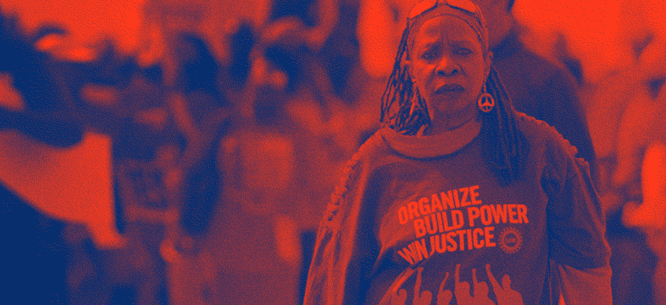Left in the Middle
Left in the Middle
Amid the failures of the Trump administration, the good news is that a left does exist in Red America—and is growing.
Introducing the special section of our Summer issue.

A few days after last fall’s election, Michael Moore went on MSNBC to explain why he thought Donald Trump had carried, narrowly, the Midwestern states that proved critical to his shocking victory. As “an angry white guy over the age of 35” with “just a high-school education,” the filmmaker claimed insights many of his fellow progressives lacked.
He drove that point home with a comment about headgear. Moore recalled that when the Trump campaign reported spending more money on “Make America Great Again” hats than on any other single expense, liberals in the media had chuckled. “I looked at that and I thought, ‘Wow, there’s the bubble right there. They don’t understand,’” he said, donning his own cap. “This is where we’re from. This is where I live,” he continued. Anyone who made fun of people who wore Trump hats, Moore insisted, was revealing their ignorance about the group whose shift away from the Democrats decided the election. In his part of America, baseball caps are everyday wear, and a Trump hat was a splendid form of campaign advertising.
It is tiresome to keep debating why Hillary Clinton lost to a man who has become the most despicable and dangerous president in our lifetimes. But if we hope to build a majoritarian left in this country, it remains essential to understand the people, of all backgrounds and political persuasions, who live in what we now call Red America but which used to go by the less partisan name of “middle America.” As the progressive journalist Michael Tomasky wrote recently, “these people in middle America, even the actual liberals, have very different sensibilities than elite liberals who live on the coasts.” They tend to attend church more regularly, own more guns, and “don’t feel self-conscious saluting the flag.” As a group, they are also poorer and less educated, with fewer chances of markedly improving their economic well-being anytime soon. Of course, a racial hierarchy endures and this is a key reason why white people in red states vote consistently and overwhelmingly Republican. Still, the injuries of class are more routine and fester longer there.
The good news is that a left does exist in Red America—and, amid the failures of the Trump administration, appears to be growing. Its adherents may share, in whole or in part, the cultural proclivities of the more numerous conservatives who live there. But they are arguing and organizing for many of the same demands as are their counterparts in places like New York City and Los Angeles; they are also busy defending the same people at risk from Trump and his allies in Congress and their own states. In this special section of Dissent, you will learn about some of those activists and a few of the politicians who share their goals.
Conventional wisdom maintains that Ohio is the quintessential swing state. But last year, it swung decisively to Republican candidates from Trump on down. In my conversation with Senator Sherrod Brown, long a pro-labor stalwart, he explains why that happened and outlines a provocative plan for valuing work and workers that has the potential to revive the image of the Democratic Party as a party for ordinary middle Americans again.
In Mississippi, reports Michelle Chen, a mostly African-American force of auto workers is challenging Nissan to recognize their union. In a region where organized labor has always struggled at the margins, the success of this drive would give hope to overworked and badly paid wage-earners throughout the South.
One state over to the east, the people and elected officials of Birmingham, Alabama, are fighting the Republican legislature for the right to set a minimum wage that might lift full-time workers out of poverty. Scott Douglas, a leader of that drive, analyzes its history and the strategy that might prove a model to urban activists in other states dominated by white conservatives.
Next, Sarah Jaffe interviews three labor organizers toiling in different parts of the South. They speak honestly about the difficulties of surmounting the racism that often keeps white workers from joining in union campaigns with black people and Latinos. As was true in labor upsurges in the past, only patient persuasion about specific demands can defeat ingrained suspicions.
The final two pieces in the section offer, in quite different ways, the promise of overcoming Trumpism and its grim apostles. In her home state of Nebraska, the historian Julie Greene reports on a large network of local organizations that fight, with some success, to protect the rights of immigrants, both legal and undocumented, and to challenge the bigotry of white citizens toward the fast-growing population of their neighbors from south of the border who today work and live among them.
Finally, back in the South, Kate Aronoff sees the potential for building a new kind of progressive coalition in an institution that dates back to the Great Depression: citizen-owned and -run electric cooperatives spawned by the Tennessee Valley Authority. In their defense of public power, the staffers of these groups are fighting calls for privatization, while trying to expand their use of renewable sources. From such roots, a truly “populist” economy might grow.
With empathy for the needs of ordinary people as well as shrewd strategies, leftists in Red America will keep confronting the enemies of a pluralist, democratic society where they work and live—and at the polls in 2018 and beyond. For their efforts to succeed, American progressives should support them, even when they sometimes disagree. To paraphrase Lincoln, a nation cannot long endure half blue and half red—at least not as a humane place of equal opportunity for the majority of its people.
Michael Kazin is editor of Dissent.





